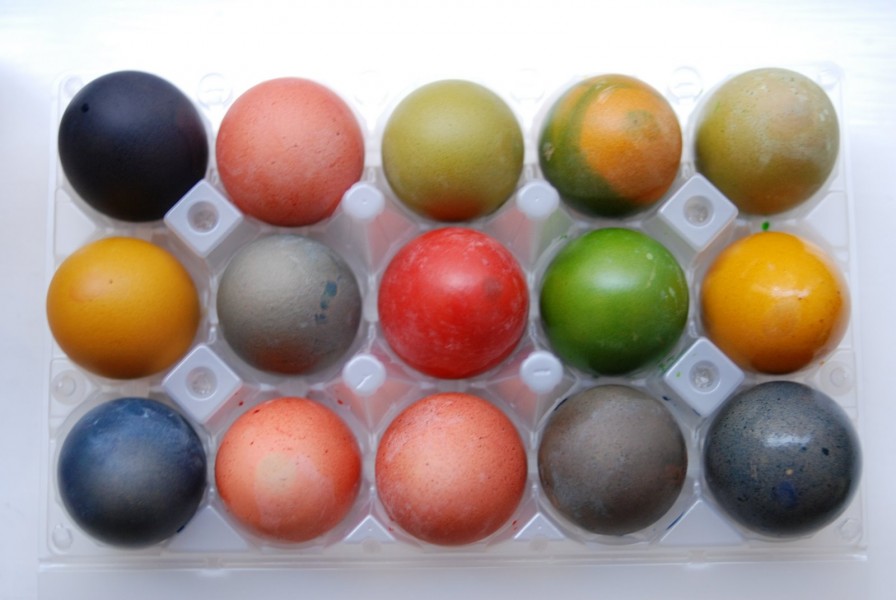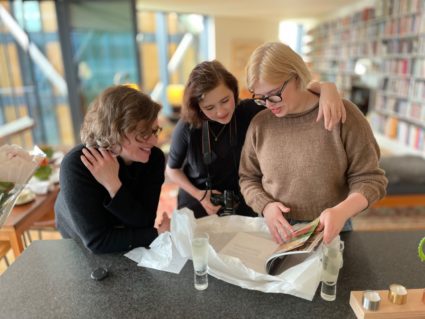“pan-basting” if you like


 But first, before I tell you about my new approach to cooking (I know there’s nothing new under the sun, but it’s new to me), just look at our Easter. Snow! I ask you. I am a big fan of snow, but on Easter? It absolutely pelted down for the better part of the morning, even sticking on the grass in the garden for a bit. Insane. First we were caught in the hailstorm the day before, and now this. Poor Easter bunny. But our egg-dyeing was a huge success. As we found on our first Easter in this lovely land, there are no white hen’s eggs to be found, at least I’ve never found any. Blue, green, pink and brown, but no white. And no egg dye, but we have long known a dirty little secret: just plain food colouring works a treat. The colours turn out so intense, as you can see, that they put white eggs and all those fancy dyeing kits to shame. We had a ball, but Avery’s apron will never be the same. Oh, and you want white eggs? Gotta go for duck.
But first, before I tell you about my new approach to cooking (I know there’s nothing new under the sun, but it’s new to me), just look at our Easter. Snow! I ask you. I am a big fan of snow, but on Easter? It absolutely pelted down for the better part of the morning, even sticking on the grass in the garden for a bit. Insane. First we were caught in the hailstorm the day before, and now this. Poor Easter bunny. But our egg-dyeing was a huge success. As we found on our first Easter in this lovely land, there are no white hen’s eggs to be found, at least I’ve never found any. Blue, green, pink and brown, but no white. And no egg dye, but we have long known a dirty little secret: just plain food colouring works a treat. The colours turn out so intense, as you can see, that they put white eggs and all those fancy dyeing kits to shame. We had a ball, but Avery’s apron will never be the same. Oh, and you want white eggs? Gotta go for duck.
So, enough about unseasonable weather and the everlasting smell of post-Easter sulfur in the air, what I want to tell you about is my new cooking method. It’s something I have seen on all the fancy cooking shows like Masterchef and Great British Menu (we are pathetically addicted to these programmes and it’s turning Avery into quite the little food critic), but I’d never tried it myself. I have named this approach “pan-basting,” because that’s what you do. Now, normally when I cook from a skillet it’s pretty boring. I heat up some oil or butter or a combination of both, stick the foodstuff in and let it cook. But listen to this: how about if you tip the skillet to one side now and then to gather up the oil, butter and cooking juices in a large spoon, and then pour it all over whatever you’re cooking? If you do this constantly throughout the cooking process, and you don’t just let your meat or chicken or fish sit there while all the basting liquid travels to the edges of your skillet into a wasteland of oblivion, the flavours are amazing! And it makes cooking more fun, as well, because there’s something to do and you can watch and keep track of the juices accumulating and USE THEM.
I discovered this in the Cotswolds with a lovely pork tenderloin. The poor little thing looked so dry and lonely! And then I noticed all that lovely juice and olive oil, plus the chopped rosemary and grated lemon zest I’d marinated it in, accumulating at the edges of the skillet. So I poured in a dot of white wine and let the skillet deglaze, tipped the skillet, scooped up all the lovely glop, poured it over, and my life will never be the same. It’s such a rich, celebratory method! Then, right at what I thought should be the end of cooking time, I decided that since it was only us, I’d cut into the fillet in the middle and just check, and lord have mercy, it was nowhere near done. So I rashly cut each half in half, giving me four tidy little pork logs, and proceeded with my basting, plus I stood each little log on its ends so they got seared and juicy too. Oh, it was a revelation. If I were willing to go whole hog on the butter, it would be even better, but for some misguided health reason, I kept it to olive oil.
Well, since then I’ve been “pan-basting” with reckless abandon. Salmon fillet? You bet, baste him with that lovely dill butter he’s cooking in. Pour it all over the fillet, then turn it over and do the same again. Lovely! And perhaps the nicest experiment was this:
Pan-Basted Chicken Breasts with Prosciutto, Mozzarella and Spinach
(serves 4, with a bit left over, probably)
4 large chicken breasts, boneless and skinless (although skin might be nice)
2 balls buffalo mozzarella, sliced thick
8 slices prosciutto
2 handfuls baby spinach
1 tbsp olive oil
2 tbsps butter
1/2 pound button or chestnut mushrooms, quartered
sprinkle dried basil
sea salt
fresh-ground black pepper
8 toothpicks (or you could tie them up if you know how: I don’t)
Lay the chicken breasts one at a time on your cutting board and flatten them out, pushing that nice little tender bit to the side but keeping it attached. Cover the surface of each breast with mozzarella slices, prosciutto and spinach leaves. Then roll it all up, or fold it, depending on how thick it is, and secure it with the toothpicks, folding any straggly bits in and catching as much as you can with the toothpicks. The idea is to keep as much mozzarella as possible inside the pocket, since the ham and spinach won’t try to move.
Now heat your oil and butter in a large skillet and sprinkle in the basil, salt and pepper. When it’s all sizzling and bubbling and lovely, place the breasts carefully in. Throw the mushroom quarters in as well. Cook the chicken on one side until it becomes opaque and white, no longer pink (about five minutes, perhaps). Turn and do the same on the other side. By this time some juices will have been released and turned into a delicious liquid with the oil and butter. Don’t taste it, though! Too raw. Wait till it’s thoroughly cooked before you taste it for salt. Tip the skillet and spoon up the juices in a soup spoon, and drizzle it over each breast in turn, continuing to tip the skillet when the spoon’s empty.
What you’ll find is that the mozzarella melts and some of it escapes into the cooking juice, which means you’re pouring INTO and on top of the delicious pocket of chicken a complex ambrosia of oil, butter, cheese, basil, salt, pepper and chicken juices. Turn the pockets on their sides, too, and brown all over. It’s hard to overcook this dish because the ham and cheese moisturise the chicken, so don’t worry too much. Keep spooning those juices as often as you like. It’s fun!
When you’re sure the breasts are thoroughly cooked (you can verify this by looking at the bit of inside pocket that’s visible, and make sure it’s no longer pink at all), taste the cooking liquid and add salt or more pepper as needed. Finally, lift the breasts and mushrooms out carefully with tongs and just leave all that oil and butter fat behind: it’s done its job. Lovely.
***********************
I’m devoted to this method now. It would be a wonderful way to cook a beef fillet, as that cut can run to dryness. A rack of lamb would be simply fabulous this way, with fresh chopped rosemary and lemon juice added to the oil or butter. Sadly, a by-product of our lovely Cotswolds holiday and visit to the Mecca of Baby Lambs has meant that Avery is no longer willing to countenance lamb as FOOD. But there will come her school holiday to Normandy next month and you can bet that hard-hearted John and I will be reaching for that rack. “Mummy, how CAN you? After you fed it with a bottle!” Needs must.
Right. We must run Avery over to her friend Sophie’s house for a sleepover and tomorrow’s matinee of “The Jersey Boys.” I’m celebrating the only good thing about having her gone: eating things she doesn’t like. It’s crabcakes and that lovely scallop dish I told you about a bit ago, with beetroot and potatoes. We’ll see if the first time making it was a fluke… I think I’ll pan-baste them! And then I promise to stop talking about it. Seriously.
Oh, and I nearly forgot to tell you about the dessert Avery invented on Easter Sunday. We had an absolute ball cooking together, but I must confess: she’s rubbish at washing up. I guess great chefs have people to do that sort of thing for them (mothers).
Avery’s Strawberry Nests
(one per person!)
8 sheets puff pastry, cut a little larger than the size of your individual tart pan
3 tbsps melted butter
handful chocolate chips, melted
homemade strawberry whipped cream (recipe below)
2 strawberries, halved
1 tbsp raspberry coulis (recipe below)
Brush butter on each sheet of puff pastry in turn and pile them up. Then nestle them into the tart pan. Spread the bottom with melted chocolate, and fill up the tart with whipped cream. Arrange the strawberries on the cream and drizzle with coulis. Gorgeous!
Strawberry Whipped Cream
1/2 pint whipping cream
dash vanilla extract
2 tbsps sugar (less if you like)
3 strawberries, quartered
Place all the ingredients in your Magimix and whizz until the cream is whipped, taking care that you don’t whip it too long and end up with strawberry butter!
Raspberry Coulis
1 pint raspberries
2 tbsps sugar
juice of 1/2 lemon
Simmer all ingredients in a small saucepan, pressing on the berries with a spoon. Cook down until liquidy, then pass through a sieve into a cup, to eliminate the seeds. Return to saucepan and cook down till reduced by about half.
******************
Enjoy!

